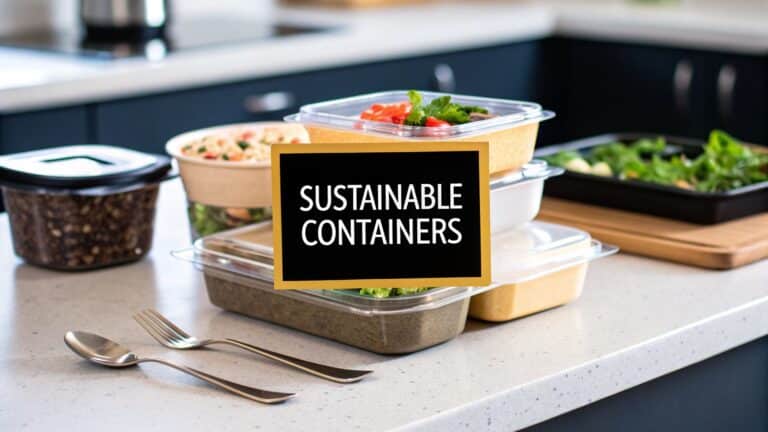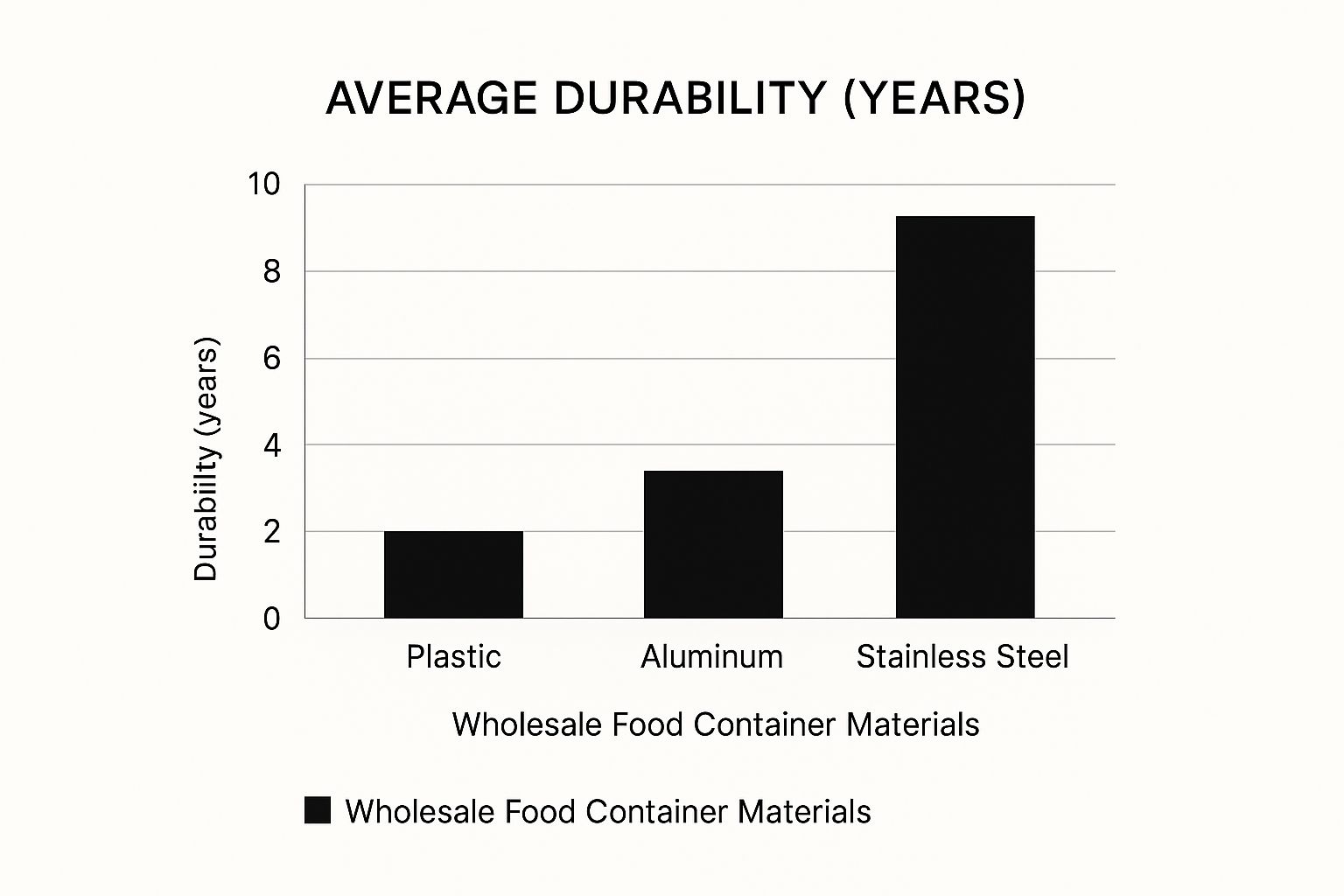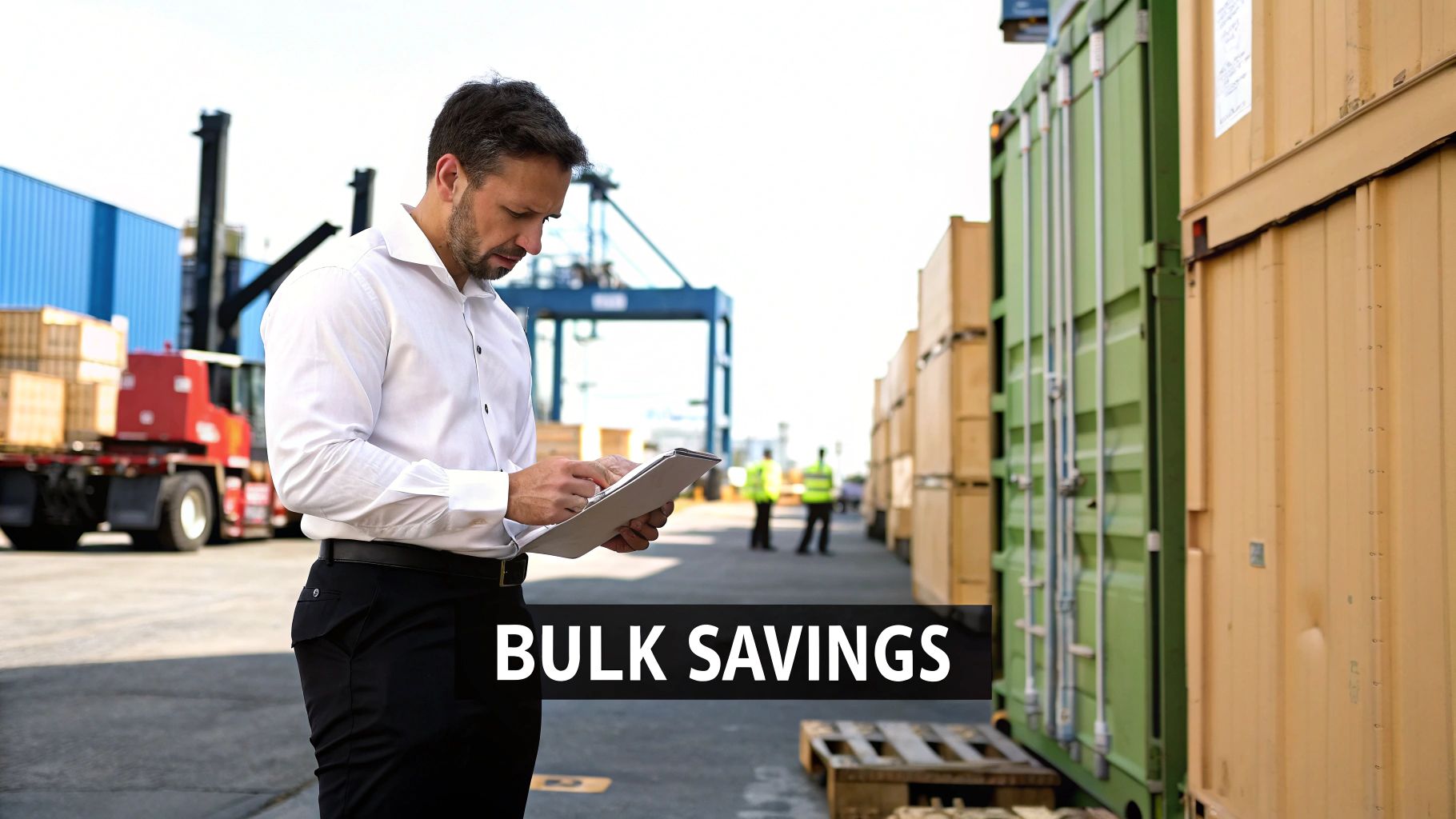Navigating the Evolving Wholesale Food Container Landscape
The wholesale food container industry is changing. Consumer behaviors and market dynamics are driving this shift. The growing demand for convenient and sustainable food packaging is a major factor.
For example, the increasing popularity of food delivery services and on-the-go meals has significantly increased the need for practical and dependable food containers. This requires a closer examination of how businesses are adapting.
Understanding the Growth Drivers
A key factor shaping the industry is the consumer desire for convenient, ready-to-eat meals. This trend, combined with rising disposable incomes globally, has fueled substantial growth in the food service industry. This, in turn, increases the demand for wholesale food containers that maintain food freshness and safety.
Growing environmental awareness is another important driver. Consumers are pushing businesses towards sustainable practices, including eco-friendly packaging. This has spurred innovation in biodegradable and reusable container options. Understanding these changing consumer preferences is critical for success in this competitive market.
The global food storage container market is booming. In 2024, the market was valued at approximately USD 163.5 billion. Projections show a CAGR of 4.5% from 2025 to 2034. This impressive growth is largely due to the increased demand for convenient and durable packaged food options. Strategic planning is essential for businesses in the wholesale food container sector.
Adapting to Changing Regulatory Environments
Regulations related to food safety and environmental protection are also transforming the wholesale food container industry. Stricter regulations on single-use plastics are being implemented in some areas, encouraging businesses to explore alternative materials. However, these regulations also create opportunities for innovation and the adoption of sustainable practices. Navigating these changing regulations is vital for businesses in this industry.
Embracing Innovation and Practicality
The evolving landscape requires a balance of innovation and practicality. Businesses need functional containers, like temperature-resistant and stackable ones. But these containers must also align with brand image and sustainability goals. This presents both challenges and opportunities for companies across the supply chain. Companies must stay adaptable and informed to meet changing demands and capitalize on new opportunities.
Selecting the Perfect Wholesale Containers for Your Business
Choosing the right wholesale food containers is much more than simply finding something to hold your product. It’s a key component of your brand experience and a major factor in your operational efficiency. From temperature-resistant plastics for hot foods to elegant glass jars for premium products and innovative plant-based options, the choices are plentiful. This section explores the crucial factors to consider when making this important decision.
Material Matters: Balancing Durability, Cost, and Sustainability
Your choice of container material directly affects food quality, shelf life, and how customers perceive your brand. Plastic containers are often the most budget-friendly, offering versatility and a lightweight design. Glass containers, though pricier, provide an upscale look and feel, perfect for high-end products. Aluminum offers a balance of decent durability and recyclability. Up-and-coming plant-based materials offer eco-conscious alternatives, but their cost and availability can sometimes be limiting.
Let’s take a look at how different materials stack up against each other:
As the data clearly shows, stainless steel boasts the longest lifespan, followed by aluminum and then plastic. This underscores the importance of factoring in long-term costs and the possibility of reuse when choosing your container material. This can influence your bottom line over time.
To further explore the nuances of each material, refer to the comparison table below:
Comparison of Wholesale Food Container Materials
| Material Type | Durability | Cost Level | Temperature Range | Best Food Applications | Environmental Impact |
|---|---|---|---|---|---|
| Plastic | Moderate | Low | Varies widely depending on plastic type | Wide range of applications, from takeout to storage | Can be recyclable, but some types are not biodegradable |
| Glass | High | High | Can withstand high and low temperatures | Premium products, preserves, and items requiring visibility | Highly recyclable and reusable |
| Aluminum | Moderate | Medium | Good heat conductivity, suitable for baking and freezing | Ready-to-eat meals, baked goods, and take-out containers | Highly recyclable |
| Plant-Based | Varies depending on the material | Medium to High | Varies depending on the material | Eco-conscious brands, takeout, and compostable options | Biodegradable and compostable, reducing environmental impact |
| Stainless Steel | Very High | High | Excellent heat resistance | Durable food storage, catering, and high-end applications | Recyclable and long-lasting |
This table offers a concise overview of the diverse options available. While plastic remains a cost-effective choice for many applications, glass offers a premium feel and excellent preservation qualities. Aluminum strikes a balance between cost and durability, and plant-based materials cater to environmentally conscious businesses. Stainless steel, with its exceptional durability, is ideal for heavy-duty use.
Functionality First: Matching Containers to Your Needs
Think about the practical aspects of your containers. Will they hold hot or cold food? Do they need to be microwave-safe or freezer-safe? Stackability is essential for efficient storage, and moisture barriers can drastically extend the shelf life of your products. Temperature tolerance is another critical element, particularly for delivery services where food might be exposed to fluctuating temperatures.
- Hot Foods: Choose containers with high-heat resistance and secure lids to prevent spills.
- Cold Foods: Select containers that maintain a stable temperature and prevent condensation.
- Delivery: Prioritize durability, insulation, and tamper-evident seals.
Aesthetics and Branding: Enhancing the Customer Experience
Beyond simple functionality, your containers contribute significantly to your brand image. Clear containers let customers see your product, while opaque containers offer a sleek, minimalist aesthetic. Custom printing can strengthen your brand identity and provide a memorable unboxing experience. Consider how your container choice reflects your brand’s values and appeals to your target demographic. Eco-friendly materials, for instance, demonstrate a commitment to sustainability, appealing to environmentally conscious consumers.
Cost-Effectiveness: Calculating the True Value
The lowest price isn’t always the best deal. Factor in the cost per use, considering durability and the potential for reuse. While premium containers may have a higher initial cost, they can offer better long-term ROI through reduced breakage, increased customer satisfaction, and better product preservation. Negotiating with suppliers for bulk discounts and preferential delivery schedules can also boost your overall cost-effectiveness.
Why Disposable Containers Are Transforming Food Businesses
The food industry is constantly evolving. Disposable wholesale food containers are playing a key role in this change. These containers are no longer simply a convenient choice; they’re vital tools for many food-related businesses. The growing popularity of food delivery services and the increasing need for grab-and-go meals are major drivers of this shift.
Streamlining Operations and Enhancing Customer Experiences
Disposable containers offer a range of benefits for businesses. They streamline operations by removing the need for washing and sanitizing, saving both time and labor costs.
Clever designs, such as compartmentalized layouts and secure sealing mechanisms, also improve the customer experience. Secure lids prevent spills during delivery, and separate compartments help keep different food items from mixing. These thoughtful details can significantly boost customer satisfaction and encourage repeat business.
Balancing Convenience With Environmental Responsibility
The increased use of disposable containers raises environmental concerns. Many businesses are actively looking for eco-friendly solutions. This focus has led to the development of hybrid containers. These newer options offer the convenience of disposability with less environmental impact.
They often include biodegradable or compostable materials. This allows businesses to meet consumer demand for convenience while addressing growing environmental concerns. The disposable food containers market is also experiencing significant growth. In 2024, it generated USD 18,541.4 million in revenue. Projections suggest it will reach USD 29,774.8 million by 2035, with a CAGR of 4.4% between 2025 and 2035.
Practical Considerations for Strategic Packaging Decisions
Several practical factors should guide your choice of disposable food containers. Storage efficiency is a key consideration, particularly for businesses with limited space. The ability to neatly stack containers helps maximize storage capacity.
Cost-per-use calculations are also essential. Some disposable containers might appear cheap initially, but may not be as durable. This can lead to higher overall costs if frequent replacements are needed.
Finally, customer perception matters. The containers you choose reflect your brand image. Consider your target demographic and their preferences. High-quality, eco-friendly options can communicate care and responsibility, improving your brand’s reputation. Carefully considering these elements leads to better packaging decisions that benefit both your business and the environment.
Sustainable Packaging: Beyond the Eco-Friendly Buzzwords
Consumers are increasingly aware of the environmental impact of their purchasing decisions, and food packaging is no exception. Sustainability is a key factor for many, transforming it from a niche market into a mainstream expectation. This shift presents both a challenge and an opportunity for the wholesale food container industry. How can businesses navigate the complexities of sustainable packaging and make choices that are both environmentally responsible and commercially viable?
This section explores how businesses can embrace genuine sustainability in the food packaging sector and strengthen their brand reputation.
Cutting Through the Greenwashing: Defining True Sustainability
The term “eco-friendly” is often used loosely. It’s essential to look beyond marketing jargon and understand what true sustainability actually means. True sustainability considers the entire lifecycle of a product–from raw material sourcing and production to its end-of-life management. It means minimizing resource depletion, waste reduction, and mitigating environmental impact at each stage.
Reimagining Container Design: Less Material, More Functionality
Leading brands are developing innovative approaches to reduce material usage without impacting functionality. This includes designing wholesale food containers with optimized shapes and dimensions to minimize waste while maximizing storage. Lightweighting techniques, which use less material without sacrificing structural integrity, also significantly reduce a container’s environmental footprint.
Exploring Emerging Technologies: Biodegradables and Beyond
New technologies continuously reshape the packaging landscape. Biodegradable polymers and plant-based alternatives are becoming viable options for wholesale food containers. These materials decompose naturally, reducing landfill waste and minimizing long-term environmental impact. Furthermore, embracing the circular economy, where materials are reused and recycled, is gaining momentum.
Evaluating Sustainability Claims: A Practical Framework
Navigating the various sustainability claims requires a clear framework for evaluation. Businesses need tools to make informed decisions, and this involves:
- Understanding Certifications: Look for reputable third-party certifications that validate environmental claims.
- Analyzing Lifecycle Assessments: Consider the full environmental impact, from production to disposal.
- Transparency from Suppliers: Require transparent communication about manufacturing processes and material sourcing.
Communicating Your Eco-Friendly Initiatives: Authenticity Matters
Consumers are discerning and can spot inauthentic marketing tactics. Communicate sustainability efforts honestly and transparently. Focus on concrete actions and measurable results rather than vague claims. This fosters trust and enhances brand reputation.
Sustainable Food Container Options and Their Environmental Impact
The following table provides a comparison of several sustainable food container options, highlighting their environmental impact, commercial viability, and consumer acceptance:
| Container Type | Biodegradability | Recyclability | Production Impact | Cost Premium vs. Traditional | Market Adoption Rate |
|---|---|---|---|---|---|
| Molded Fiber | High | Limited | Moderate | Low to Medium | Growing |
| PLA (Polylactic Acid) | High (Commercially Compostable) | Limited | Moderate | Medium to High | Increasing |
| Bagasse (Sugarcane Fiber) | High | Limited | Low | Low to Medium | Growing rapidly |
| rPET (Recycled PET) | Low | High | Lower than virgin PET | Low to Medium | High |
| Glass | None | High | High (Energy Intensive) | High | Stable |
This table illustrates the diverse range of sustainable options available. Molded fiber, PLA, and bagasse offer high biodegradability, aligning with composting initiatives. rPET provides high recyclability, reducing reliance on virgin plastic. While glass offers excellent recyclability and reusability, its production is energy-intensive. Selecting the right option depends on balancing environmental impact with practical considerations like cost and availability.
By embracing innovation and transparency, businesses can strategically leverage sustainable packaging for brand differentiation in the competitive wholesale food container market.
Maximizing ROI on Your Wholesale Container Investment
Smart purchasing goes beyond finding the lowest unit price for wholesale food containers. It’s about evaluating the total cost of ownership, considering factors like storage, potential breakage, and even how packaging influences customer perception.
Calculating True Cost: Beyond the Price Tag
Savvy businesses analyze the true cost across different container options. This involves calculating the cost per use, factoring in durability and reuse potential. A premium glass container, for instance, might have a higher upfront cost than plastic, but its durability and reusability could lead to lower costs over time.
Storage is another key factor. Compact, stackable containers maximize space and reduce warehouse expenses.
Negotiation Strategies: Securing the Best Terms
Effective negotiation significantly impacts your bottom line. Strong supplier relationships unlock volume discounts, preferential delivery schedules, and even early access to innovative container designs. This proactive approach helps secure the best terms and a competitive edge.
Inventory Management: Balancing Supply and Demand
Efficient inventory management is crucial for ROI. Balancing carrying costs against stockout risks is key. Too much inventory ties up capital and increases storage costs. Too little inventory, however, can lead to lost sales and unhappy customers. Finding the sweet spot ensures you have enough packaging without excess overhead.
As businesses minimize their environmental impact, sourcing eco-friendly packaging becomes vital.
Assessing the Value of Premium Containers: When Quality Pays Off
Sometimes, premium wholesale food containers offer a better ROI. Reduced breakage minimizes replacement costs and product loss. Enhanced customer satisfaction through premium packaging can boost brand loyalty and sales.
Furthermore, premium containers can extend shelf life, reducing spoilage and maximizing product value. The global food containers market, estimated at USD 331.7 billion in 2024, is projected to grow at a CAGR of 4.5% from 2025 to 2030. This growth is fueled by factors like on-the-go lifestyles and demand for convenient packaged foods.
Data-Driven Decisions: Optimizing for Long-Term Value
Analyzing these factors enables data-driven decisions about container investments. Optimizing for both immediate expenses and long-term value requires a comprehensive approach, ensuring your packaging choices support your business goals and contribute to overall success.
Building Strategic Partnerships With Container Suppliers
The right supplier can be crucial for your wholesale food container strategy. A solid partnership elevates this area from a simple expense into a real competitive advantage. This involves looking beyond the lowest price and building mutually beneficial relationships. This section explores identifying, vetting, and nurturing relationships with top-tier suppliers.
Identifying Potential Partners: Beyond The Basics
Finding the right wholesale food container supplier takes more than a quick Google search. Industry events, trade shows, and recommendations from your business network are excellent starting points. Online directories focusing on packaging and wholesale can also connect you with potential suppliers. This broad search helps you consider a diverse pool of partners.
Due Diligence: Vetting Suppliers For Reliability
Thorough due diligence is essential once you’ve identified potential suppliers. This involves more than just checking prices.
- Sample Testing: Requesting samples of various container types lets you assess quality directly. This helps determine the container’s durability, functionality, and suitability for your products.
- Production Facility Evaluations: If possible, visit supplier facilities or request virtual tours. This provides insight into their commitment to quality control and ethical manufacturing.
- Reference Checks: Speaking with other businesses that use the supplier offers valuable insights into their reliability, communication, and ability to meet deadlines.
These steps ensure you partner with a reliable supplier who can consistently meet your needs.
Negotiation Strategies: Securing Preferential Treatment
Negotiation is key for securing favorable terms. Discuss volume discounts, flexible payment options, and preferential lead times. A strong partnership involves open communication and mutual benefit. This could mean negotiating priority during material shortages or early access to container innovations.
Contingency Planning: Diversifying Your Supply Chain
Depending on a single supplier, no matter how dependable, creates vulnerability. Building relationships with multiple suppliers provides a safety net. This minimizes disruptions if one supplier faces production delays or shortages. It also leverages competitive pricing and access to a broader range of container options.
Managing Quality Control: Maintaining Consistent Standards
Maintaining consistent quality control across your wholesale food containers is vital, even with trusted suppliers. Regular inspections and clear quality standards help identify potential issues early.
Fostering Long-Term Partnerships: Adapting To Changing Needs
Your business needs will change. Long-term supplier partnerships enable them to adapt with you. Communicate your evolving requirements, offer performance feedback, and collaborate on solutions for a flexible and responsive supply chain.
Practical Checklist For Evaluating Suppliers
Here’s a quick checklist for supplier evaluation:
- Product Quality: Do they offer high-quality containers that meet your needs?
- Pricing and Payment Terms: Are prices competitive and payment terms favorable?
- Reliability and Lead Times: Can they meet deadlines and deliver on time?
- Communication and Customer Service: Are they responsive and provide excellent support?
- Sustainability Practices: Do they align with your environmental values and offer eco-friendly options?
- Innovation and Adaptability: Are they open to new ideas and adapting to your changing needs?
By carefully evaluating and actively cultivating supplier partnerships, you can transform your wholesale food container strategy from a routine cost into a driver of efficiency, customer satisfaction, and brand differentiation.
Ready to elevate your food packaging and streamline operations? Explore the high-quality wholesale food containers at MrTakeOutBags.com. Our expert team offers personalized consultations to find the perfect packaging solutions for your business needs.







Comments are closed.